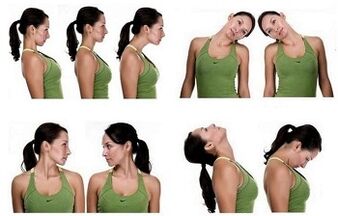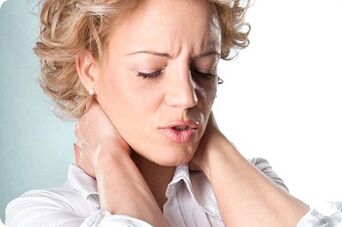
The tendency to grow degenerative dystrophic lesions of the spine is steadily increasing every year and all this, because the problem of hypodynamia and hypokinesia is acute due to urbanization.Damage to the cervical spine causes frequent, various intensities of headache and a sense of stiffness in the neck and forearms.Today, our topic is the causes, symptoms and treatment of osteochondrosis of the cervical region.
The causes of the development of cervical osteochondrosis
Speaking of the causes of degenerative damage to the cervical spine, genetic, toxic, metabolic, endocrine, infectious and others can be listed.First of all, however, you can put a sedentary lifestyle and sit on your computer, desk and driving.
The frequent stresses that the stop posting inadvertently make the blood vessels of the neck of the nerves, help to support this pathology.
Symptoms of neck pain should not be ignored as this leads to the progression of the disease and the development of such complications as periatrosis, carrying a shoulder, spinal artery syndrome, anterior staircase syndrome and Roying syndrome.
For the anatomical structure
Now let's see what the anatomical and physiological features of the structure of the cervical spine contribute to the development and progression of osteochondrosis:
- The cervical part is the most mobile section of the spine.Since all types of movements are possible in it, this increases the risk of subluxation and frequent disorders;
- The pelvic artery is performed in the channel formed in the holes of the transverse processes of the vertebrae.It is a blood flow of the brain, the auditory organs, the spinal nerve and the brain.With the development of degenerative dystrophic changes, the artery and nerve can be engaged in this department.
- In the cervix, the intervertebral discs are not everywhere between the vertebrae.In the front, the vertebrae are connected to joints that can provoke joint subluxation.
- The holes of the three lower cervical vertebrae have a triangular shape and with the growth of bone tissue with osteochondrosis, the nerve roots can press.
- Vegetative ganglias are located throughout the cervical department.
These characteristics will help us present the mechanism for developing complications of osteochondrosis of the cervical spine.
Mechanisms for the development of changes in the cervical spine

The pathological process begins in the intervertebral disc with the loss of moisture with the pulpal disk nucleus.The fibrous ring of the disc gradually becomes slower, its elasticity decreases and microwaves appear.
As a result, the disc loses its ability to adjust, depreciation and support.The load on the lower vertebrae gradually increases, after which the vertebra itself participates in the process.
It has small defects and osteophytes (excessive bone plants) grow to withstand increased load.
With the growth of bone tissue, the nerve roots are pressed along the posterior wall of the vertebrae and, if on the lateral surface, the spinal artery is impaired.
Subluis in the joints occur due to a violation of stability between the vertebrae.This leads to a compensatory tension of the neck muscles, which helps to maintain the cervical vertebrae in the normal position.
When the muscles get tired, the load on the vertebrae increases again, leading to the progression of the disease.In this way, a vicious circle is formed, in which the spasmodic muscles and the damaged vertebrae are adversely affected and lead to worsening in the patient's condition.
Symptoms of the disease are formed on the basis of pathological mechanisms.So, squeezing nerve roots is manifested by intense paroxysmal pain along the nerve disorders.
And with compression of the spinal artery, the symptoms associated with a decrease in blood flow to the brain, namely: tinnitus, dizziness and headache, appear first.
The main symptoms of cervical osteochondrosis.
The main symptoms of cervical osteochondrosis are conditionally divided into 3 groups:
The first group of symptoms - pain
It manifests itself in the form:
- local pain in the back of the head/neck;
- The irradiation pain that extends to the right or left hand can also go to the fingers, to the brush itself, to the forearm, and even locate the shoulder joints.
This pain can be sick and permanent, irritating and widespread all over the neck or arm.Or it is a local acute pain in firing that occurs as a result of pinching of the nerve root.
The second group of symptoms is motor disorders
First of all, it is the firmness of the neck and nape muscles, resulting in it is impossible to turn or tilt the head normally or to make some movement in the cervical spine.
In addition, it is a restriction on mobility in the shoulder joint, which is called the periatrosis syndrome on the shoulder.It is also possible to spread throughout the arm, including numbness of the fingers, numbness of the hands and numbness along the lateral surface of the shoulder or forearm.
The third group of symptoms is vegetable-vascular manifestations, manifestations from the vessels
In the course of this, a spasm of blood vessels or pinching in the spine occurs.As a result, similar symptoms of cervical osteochondrosis can occur as headache, dizziness, flip flies in front of the eyes.
There may also be hearing impairment - the noise in the ears and the feeling of a "sulfur plug" in which one does not hear well.These symptoms belong to the spinal artery syndrome.
Methods for traditional cervical osteochondrosis treatment

Modern medicine offers many methods for the treatment of degenerative dystrophic lesions of the spine.Among them, they distinguish: drug treatment, manual therapy, folk remedies, therapeutic physical culture (exercise of therapy), and in distant cases resort to surgical treatment.The effectiveness of therapy depends on what stage the treatment and a complex of selected methods have started.
Treatment should first be aimed at normalizing the muscle tone of the cervical muscles.The effect of other agents is aimed at eliminating inflammation and pain in the development of pathological changes.
An important point in the treatment of osteochondrosis is a good comfortable sleep that experts recommend that you use an orthopedic pillow.
In the early stages of the development of the disease, the use of massage in an experienced specialist and self -massage will be effective.This method will help to relax the spasmodic muscles and stop the progression of the pathological process.
Medical physical education
Treatment for osteochondrosis should include physiotherapy exercises in the form of gymnastics at therapeutic or morning hygiene.When performing a complex of treatment exercises, follow the following recommendations:
- Wear comfortable clothes and shoes;
- so that there is no shortness of breath, alternative ordinary respiratory exercises;
- The load should be increased gradually and if you began to mark complaints from the cardiovascular system during the lesson, then stop the exercise and seek the doctor's advice;
- If the pain occurs in the cervical spine during the lesson, then replace them with relaxing and stretching exercises;
- During the lesson, control your overall well -being, breathing and pulse;
- If the exercises with the hand and heaviness cause pain, then leave them for a while;
- The complex of exercise of therapeutic exercises should be agreed with the doctor.

The following effects are expected from physiotherapy exercises:
- Strengthening the neck muscles,
- Restoration of blood flow;
- Increased vertebral mobility;
- Increase in the volume of movements in the cervical region;
- Get rid of pain and restoration of the interior;
- Prevention of exacerbations.
Medication
Most neuropathologists and other experts do not represent the treatment of osteochondrosis of the cervical spine without medication.The most popular are medicines in a group of non -steroidal anti -inflammatory drugs (NSAIDs), which are used in the form of injections, tablets, gels and ointments.
Non -steroidal anti -inflammatory drugs relieve pain, inflammation and relief of swelling, as a result of the tone of the neck muscles is restored, metabolism in the affected area is improved, and nerve roots and blood vessels are released from compression.
It is advisable to use medicines from a group of muscle relaxants, which also effectively relieve muscle spasm and at the same time restore their tone.However, medicines should be used with caution, especially in allergies.

Corticosteroids have earned good examinations in the treatment of osteochondrosis of the cervical spine.
The injection drug is very popular because of its anti -inflammatory and neuroprotective effects.
If the treatment described is not effective, then they resort to the use of paravertebral blockade with painkillers or steroids.
How to treat uterine osteochondrosis with unconventional methods
Proponents of non -traditional treatment methods may use the following treatments.
- AcupunctureIt helps to save the patient from pain, relieve swelling and relax the spasmodic muscles, as well as to eliminate functional nerves and arteries.If your fingers are tingling on the hands, it is advisable to place the needles at biologically active points of the hand and the sink of the ear;
- Manual therapyIt helps to restore the normal blood flow to the neck, relieves muscle spasm and releases pressed nerves.Spinal stretching should be carried out by a qualified specialist with great care;
- Hirudotherapy (leech treatment)This is a cheap and quite effective method of treatment.The procedure consists in the placement of leeches for biologically active points, which should be repeated with a course of 10 sessions.This method helps to restore blood circulation in the cervical region, relieve swelling and inflammation;
- Supreme massageIt consists in the effects of the finger on biologically active points and helps to relieve muscle spasm, improve blood circulation, relieve swelling, pain and inflammation;
- Folk methods of treatmentYou can successfully use it at home.These are different decoctions and infusions that can be prepared alone (infusion of wormwood, infusion of lilacs, infusion of garlic).Therapeutic baths made of mint, chamomile, sage, kalamus rhizomes have a good effect.

After the above methods of treatment and learning about the mechanisms of the disease, make a solution to whom you contact your problem yourself: a neuropathologist or a private clinic.


















































